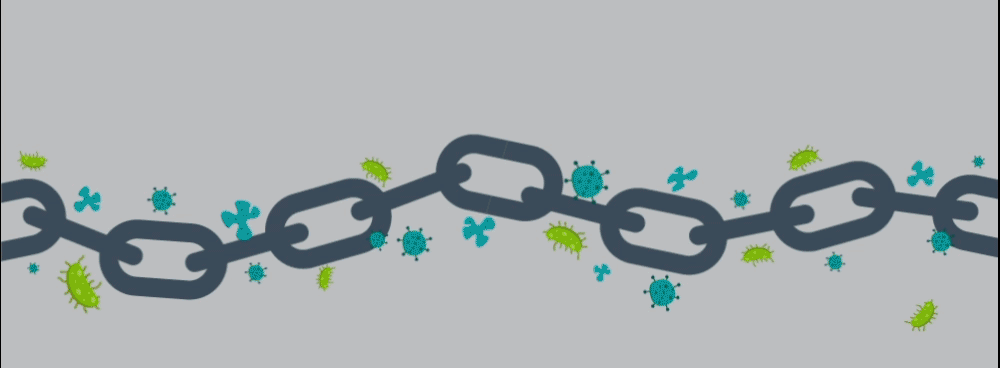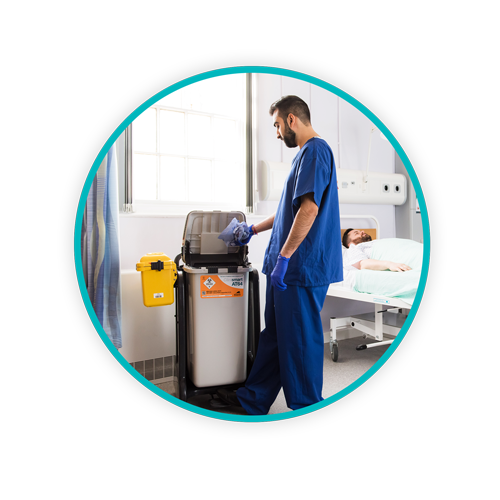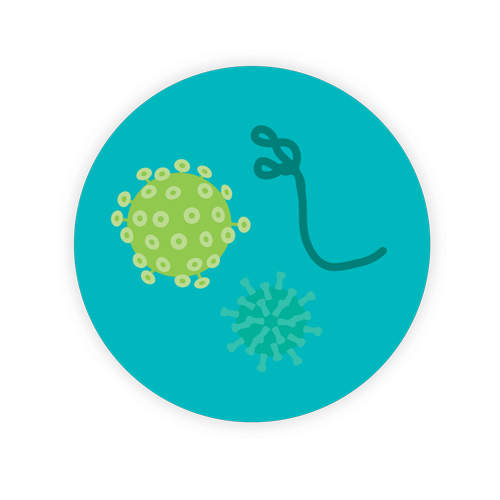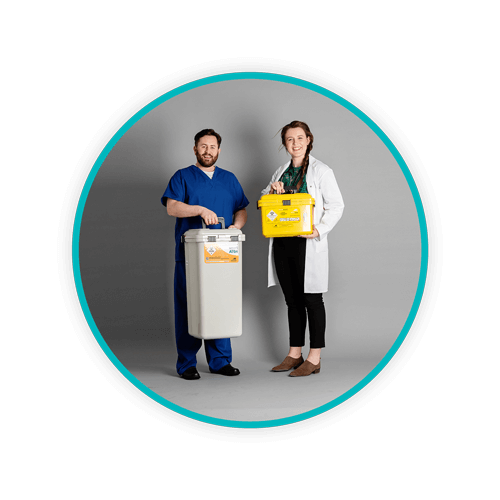How Reusable Containers Break the Chain of Infection

Can reusable sharps containers spread infection? It’s a question that needs asking, and we have the answer.
When designing reusable items for the healthcare environment, infection prevention and control principles must be factored into the design very early in the process. This is especially true with something as crucial as a reusable sharps bin. Let’s see how reusable sharps containers break the chain of infection and the peer-reviewed research that demonstrates why transmission isn’t possible.
TOPICS WE WILL COVER:
1 / What Is the Chain of Infection?
2 / Can Reusable Sharps Containers Break the Chain of Infection?
3 / Peer-Reviewed Research: Can Reusable Sharps Containers Carry and Transmit C. Diff?
4 / Skip the Read: Blog Summary
5 / Let’s Break the Chain of Infection, Together
What Is the Chain of Infection?
The chain of infection is a concept used in healthcare to understand how infections are passed from one person to another. It illustrates the sequence of conditions that must be present and intact for an infection to spread – much like links in a chain.
If all six links in the chain of infection are intact, transmission is possible. But when a single link is interrupted, it breaks the chain of infection, and transmission isn’t possible.
What Are the Links in the Chain of Infection?
#1 Infectious Agent: This is the germ that can make someone sick, the pathogen that causes diseases, like a virus, bacteria, parasite or fungus.
How to break the chain here:
Stop the germ before it has the chance to spread. This means identifying harmful pathogens early and either eliminating them or at least reducing exposure to them.
#2 Reservoir: This is where the germ lives, grows and multiplies. This could be a person, a surface, a body fluid or even a piece of equipment.
How to break the chain here:
Reservoirs need to be decontaminated or controlled. Keep the environment clean and regularly disinfect surfaces.
#3 Portal of Exit: This is how the germ leaves its host. It could be through a cough, sneeze, blood or other body fluids.
How to break the chain here:
Contain the source. Using sealed bins covering wounds and wearing PPE when appropriate helps keep germs from spreading.
#4 Mode of Transmission: This is how the germ travels from one person or place to another. It can spread through touch, through the air, on shared surfaces, or through sharps injuries.
How to break the chain here:
Stop the spread by reducing contact. Clean your hands regularly, use touch-free sharps disposal systems, handle waste carefully and disinfect shared surfaces and equipment.
#5 Portal of Entry: This is how the germ gets into a new person – through cuts, open skin, or touching your eyes, nose or mouth.
How to break the chain here:
Protect entry points. Use gloves when appropriate, dress wounds properly, avoid touching your face, and practice good hand hygiene when handling waste or patient materials.
#6 Susceptible Host: This is someone who is more likely to get sick, like a patient with a weak immune system or someone recovering from surgery.
How to break the chain here:
Protect vulnerable people and safeguard those most at risk. Use infection control practices consistently and maintain a clean care environment.
A Note on Germs and Spores
As a healthcare worker, you’re likely to be familiar with Clostridium difficile (C. diff) – a germ (bacterium) that can infect the bowel and cause diarrhoea and colitis, usually affecting people who have been taking antibiotics. But what about spores? When C. diff germs are outside the body, they become spores – a germ that has fallen asleep (inactive) in a suit of armour (protective coating) and can potentially live for a long time.
Can Reusable Sharps Containers Break the Chain of Infection?
Reusable containers should be designed to minimise infection risk. As mentioned above, each of the six links in the chain of infection is essential for disease transmission to occur. If just one of those links is broken, transmission isn’t possible.
To demonstrate how reusable sharps containers break the chain of infection, we’ll be referring to an academic study published in the American Journal of Infection Control that tested the pathogen transmission potential of reusable sharps containers.
We’ll begin by looking at one of the most likely places within the clinical setting to see the spread of infection take place.
The Patient Environment
The patient environment may serve as a reservoir for the transmission of C. diff spores to susceptible patients. The surfaces most commonly associated with Clostridium difficile infection (CDI) transmission are high-touch, contaminated surfaces close to patients.
Confirming that a ‘pathogen‘, ‘portal of entry‘, ‘susceptible host‘, and ‘portal of exit‘ are present, leaves ‘reservoir‘ and ‘mode of transmission‘ to investigate to determine the possibility of reusable sharps containers being associated with infection transmission.
Reusable Containers as a Reservoir for Infection
Not all surfaces have the capability to act as a reservoir for C. diff, and to classify a sharps container as a reservoir, it needs to be contaminated with a high enough density of the pathogen in question to amount to an infective dose.
Except for bathrooms, surfaces further from the patient’s bed are contaminated less often and less heavily than frequently touched surfaces close to the patient, such as bed rails, bedside tables, call buttons, etc. When it comes to airborne spores, they tend to group together and fall to the floor relatively quickly, but even if they did land on low-touch surfaces, it shouldn’t matter since they’re infrequently touched.
The epidemiology indicates that wall-mounted sharps containers, kept at a distance from the patient and not touched during use, would have a low spore bioburden. The spore density in the patient environment was found to be extremely low on reusable sharps containers (no higher than on disposables), and some 1000 times lower than on other surfaces in the patient environment.
This means that reusable containers would need to arrive on-site already covered in enough spores to infect someone to be in any way related to CDI. That’s implausible though, because a thorough washing process removes the spores and is one of the many conditions that an ISO compliant reusable sharps container must meet.
Can reusable sharps containers serve as a reservoir for infection?
With an insufficient number of spores found on the containers to constitute an infective dose, they meet neither the epidemiologic nor the microbiologic criteria for ‘reservoir‘.
This breaks a link in the chain of infection, and transmission isn’t possible.
Reusable Containers as a Mode of Transmission for Infection
For a reusable sharps container to act as a mode of transmission, the spores need to get from the container to the patient.
But how? There’s no bus route after all…
The most common mode of transmission of C. difficile to patients is via the hands of healthcare staff who have touched heavily contaminated surfaces close to the patient and then touched the patient.
Hands-free disposal is one of the key safety features of reusable sharps containers, allowing the user to drop a sharp into the aperture without the need to touch the container with either the depositing hand or the free hand. It’s also worth noting that clinical staff must wear gloves while attending CDI patients. It’s best practice to remove gloves (if appropriate to use) and follow hand hygiene after any patient interaction – it’s mandatory when there’s potential exposure to blood and body fluids.
Can reusable sharps containers serve as a mode of transmission for infection?
In either scenario (touchless sharps disposal and/or removal of gloves), a ‘mode of transmission‘ to a patient isn’t possible.
This breaks a second link in the chain of infection, and transmission isn’t possible.
Peer-Reviewed Research: Can Reusable Sharps Containers Carry and Transmit C. Diff?
Brace yourself for some big words and impressive numbers…
A multi-centre ‘Microbiological study to investigate the carriage and transmission potential of Clostridium difficile spores on single-use and reusable sharps containers’ explored and challenged the idea that sharps containers could play a role in CDI transmission. The researchers used a multi-faceted epidemiologic, microbiologic, chain-of-infection, and test-of-evidence approach to conduct their investigation.
The results proved the safety of reusable sharps containers. They demonstrated no foundation for the assertion that they may be a fomite (an inanimate object that can carry and spread disease and infectious agents). Before the patient environment investigation, the researchers took samples of 197 Sharpsmart containers for C. diff at processing facilities. The sharps containers were then challenged with high C. diff densities to test the efficacy of decontamination through the Washsmart process.
Following that, they sampled 50 reusable sharps containers and 50 disposable sharps containers in CDI patient rooms in seven hospitals to assess C. diff carriage.
The results of the study were:
- Stage 1: C. difficile spores were found on 9 of 197 (4.6%) reusable containers prior to processing.
- Stage 2: Decontamination processing completely removed C. difficile.
- Stage 3: 4 of 50 reusable sharps containers (8%) and 8 of 50 disposable sharps containers (16%) had sub-infective counts of C. difficile.
- 2 links in the chain of infection were found to be broken.
- 5 of 7 tests of evidence for environmental sources of infection were found to be unmet.
Skip the Read: Blog Summary
Reusable sharps containers are often questioned for their infection risk, but the science is clear – when processed through validated systems, they do not contribute to the spread of infections like Clostridium difficile (C. diff).
The peer-reviewed research on reusable containers and the chain of infection shows how they break two critical links in the chain:
- Reservoir – Thorough decontamination eliminates germs before containers re-enter clinical environments.
- Mode of Transmission – Hands-free disposal and touchless design prevent cross-contamination from person to person.
The research confirms that their design supports infection prevention principles and that properly sanitised reusable sharps containers carry no greater risk than disposables.
Now that we’ve tickled your ears with the short version, fancy the full read? Click here to return to the top.
Let’s Break the Chain of Infection, Together
Everyone working in the healthcare environment has a part to play in ensuring adherence to infection control measures.
At Sharpsmart, we understand the importance of infection prevention and control. When it comes to reusable waste solutions, Sharpsmart is the only provider that has worked directly with clinicians to design containers that meet the infection control and safety requirements of the healthcare environment.
Whether you’re looking for guidance and advice or a reliable reusable waste containment system that prioritises safety and reduces infection risk, we’re here to help.
Let's Talk!
Your time is valuable, and we don’t want to play hard to get. You can either phone us directly on the details listed on our contact page, or feel free to fill out this short form and one of our team members will get back to you as quickly as possible.




